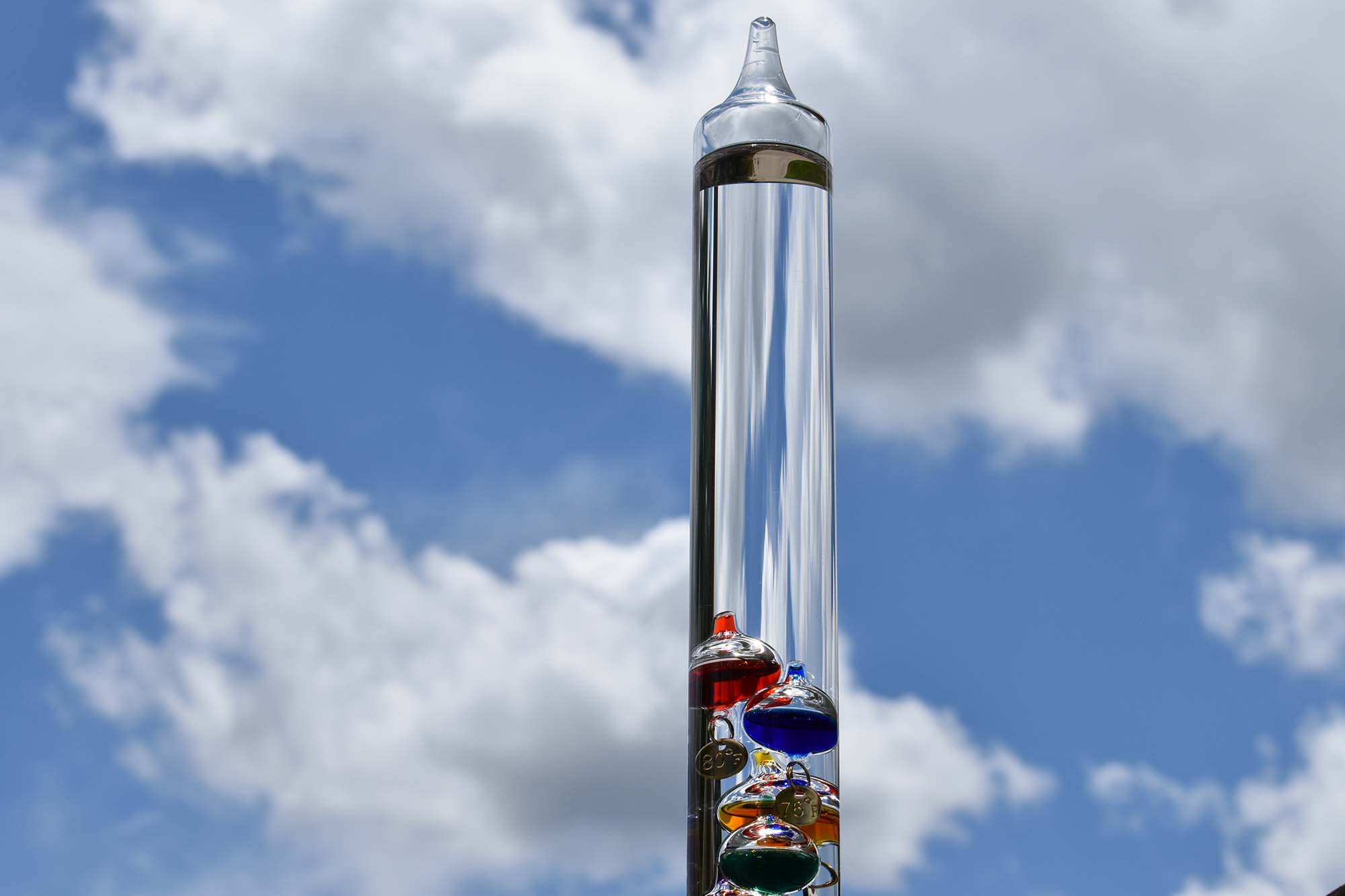The history of thermometers is a captivating journey that spans centuries and encompasses the contributions of brilliant minds and scientific pioneers. From the groundbreaking discoveries of Galileo Galilei in the late 16th century to the modern thermometers we rely on today, the evolution of temperature measurement is a fascinating fusion of science and art.
Galileo Galilei, an Italian physicist, mathematician, and astronomer, played a pivotal role in the development of thermometers. His revolutionary work in buoyancy and the interplay between density and temperature laid the foundation for the thermometer that bears his name.
While Galileo did not craft the thermometer, his pioneering insights and experiments paved the way for skilled crafters in the 17th century to bring this remarkable temperature gauge to life. In this blog post, we will explore the rich evolution of thermometers, delving into the stories and advancements that have shaped this essential tool.
Who invented the thermometer?
The thermometer’s origin can be attributed to various individuals throughout history who significantly contributed to the development of air temperature measurement, including Heron of Alexandria, Galileo Galilei, and Anders Celsius, to name a few.
The earliest documented research on thermometry can be traced back to the ancient Greek scientist, Heron of Alexandria, in the 1st century AD. Heron’s conceptual device relied on the expansion and contraction of air to indicate temperature changes, but Heron never created a working prototype.
However, Italian inventor Galileo Galilei is often credited with creating the first working thermoscope in the 16th century. Galileo’s thermoscope utilized the expansion and contraction of a liquid, typically alcohol or water, to measure temperature variations in the air.
In the 18th century, Swedish astronomer Anders Celsius introduced the Celsius scale, used today as part of the Metric system. His innovation provided a standardized system for measuring temperatures, leading to the widespread adoption of the thermometer as a crucial scientific instrument. Daniel Fahrenheit created a similar scale, which is used in the US.
Who is Santorio Santorio?
Santorio Santorio was an Italian physician and scientist who made significant contributions to the field of thermometry. Santorio is best known for his pioneering work in the 17th century on the development and improvement of the thermoscope, following Galileo’s initial work.
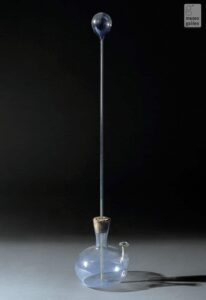
What materials were used in early thermometers?
Early thermometers were simple yet effective devices. They consisted of a glass tube filled with a liquid, typically mercury or alcohol. Thermometers were made using glass for the tube and mercury or alcohol. These materials were chosen for how they react to changes in the temperature of the container holding the liquid.
The glass was used for the tube because of its ability to withstand large temperature changes without breaking, and for easy observation of the liquid inside. Mercury or alcohol was used because of its high thermal expansion coefficient, in plain English temperature changes cause significant expansion and contraction of the liquid. This property allowed for precise measurement of temperature variations.
These liquids efficiently transfer heat from the surrounding glass, expand or contract, and are measured using a scale. Different materials were used depending on the desired temperature range and accuracy.
It is important to note that the choice of materials in early thermometers was based on the knowledge and resources available. Today, more advanced materials and technologies have led to the development of digital thermometers and other precise temperature-measuring instruments.
What was used in thermometers before mercury?
Before mercury, alcohol more specifically brandy) was commonly used in thermometers. Alcohol thermometers were invented in the 18th century and were widely used until the introduction of mercury thermometers.
Unlike mercury, which is a metal, alcohol is a liquid. While booze was an early option, it was replaced with ethanol or ethyl alcohol thermometers because it is more reactive to changes in temperature. Alcohol thermometers work on the principle that as the temperature rises, the alcohol expands up the narrow tube of the thermometer.
However, alcohol thermometers have their limitations. They are not suitable for measuring extremely high temperatures because alcohol has a lower boiling point than mercury. Additionally, alcohol is more prone to evaporating, which can affect the accuracy of the thermometer over time.
With advancements in technology and the discovery of mercury’s properties, mercury thermometers eventually replaced alcohol thermometers due to their wider temperature range and greater stability.
However, due to environmental concerns, mercury thermometers have been phased out in many applications and replaced with digital thermometers or other safer alternatives.
What is now used in thermometers instead of mercury?
In modern thermometers, mercury has been largely replaced by other substances, such as alcohol or digital sensors. This from mercury is due to concerns about its toxicity and environmental impact. Alcohol-based thermometers are commonly used in household applications, while digital thermometers utilize electronic sensors to measure temperature. These advancements have made thermometers safer, more accurate, and easier to use.
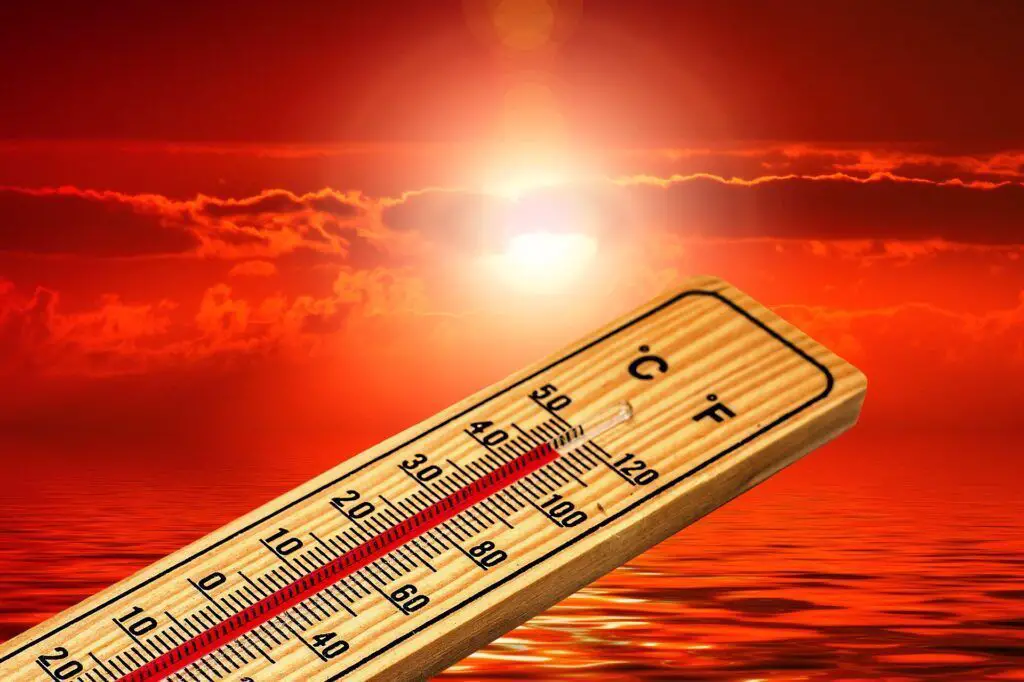
What scales are used to measure temperature?
Several scales are used to measure temperature, the most commonly used ones being Celsius (°C) and Fahrenheit (°F). The Celsius scale is based on the freezing and boiling points of water, with 0°C representing the freezing point and 100°C representing the boiling point at sea level.
The Fahrenheit scale, on the other hand, is commonly used in the United States and is based on the freezing and boiling points of water as well, with 32°F representing the freezing point and 212°F representing the boiling point at sea level.
Another is the Kelvin (K) scale, which is based on absolute zero, the point at which all molecular motion ceases. The Kelvin scale is often used in scientific and engineering applications.
What is the history of the electronic thermometer?
The history of the electronic thermometer dates back several decades. In the early 1960s, scientists and engineers began exploring ways to measure temperature using electronic components instead of traditional mercury or alcohol thermometers.
During this time, advancements in semiconductor technology allowed for the development of small and accurate temperature sensors. These sensors, known as thermistors, rely on changes in electrical resistance to measure temperature. They were the earliest form of electronic thermometers and were widely used in scientific research and industrial applications.
In the 1980s, the invention of the integrated circuit brought about significant improvements in electronic thermometers. These new devices, often referred to as digital thermometers, used digital displays to provide precise temperature readings. They were more convenient and user-friendly compared to their analog counterparts.
As technology continued to advance, electronic thermometers became more advanced and versatile. In recent years, we have seen the emergence of infrared thermometers, which use infrared radiation to measure temperature without making contact with an object or person. These devices are commonly used for medical purposes, such as measuring body temperature.
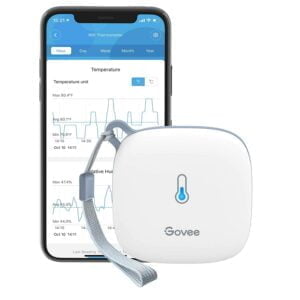
How does a Galileo thermometer work?
Galileo Galilei pioneered the principle of buoyancy, which states that an object’s buoyancy correlates with its density relative to the surrounding fluid. In simple terms, buoyancy is all about how an object floats or sinks in a fluid. This powerful insight birthed the underpinnings of the Galileo thermometer.
At the heart of these thermometers lies a simple idea, like a dance of physics in liquid form. With elegantly crafted glass orbs, each filled with a different colored liquid to a precise density, they rise or fall as the ambient temperature changes.
While we call them Galileo thermometers today, these devices have a name: a thermoscope.
The charms of the Galileo thermometer are not just within its functional genius, but also in its delightful visual appeal. Those glass orbs floating inside? They’re meticulously filled with colored liquids, each calibrated to react distinctively at different temperatures.
The glass bubbles in a Galileo thermometer are more than just a touch of aesthetic charm; they are the core of its temperature-reading magic. As simple as they look, these orbs are meticulously crafted to serve a scientific purpose.
Each bubble is filled with a colored liquid and attached to a specific metal tag that indicates a temperature. As the ambient temperature around the thermometer changes, the density of the liquid within these bubbles adjusts accordingly.
How do density changes cause the bubbles to move? It’s tied to the principles of buoyancy, as defined by Archimedes. When a bubble’s density is less than that of the surrounding liquid, buoyancy propels it upwards. Conversely, if a bubble’s density becomes greater, gravity overpowers buoyancy, and it sinks. It’s this delicate equilibrium that the Galileo thermometer exploits.
When you read a Galileo thermometer, you see these concepts of physics in action. Each floating or sinking bubble represents a specific temperature range, and the lowest floating orb shows the current ambient temperature.
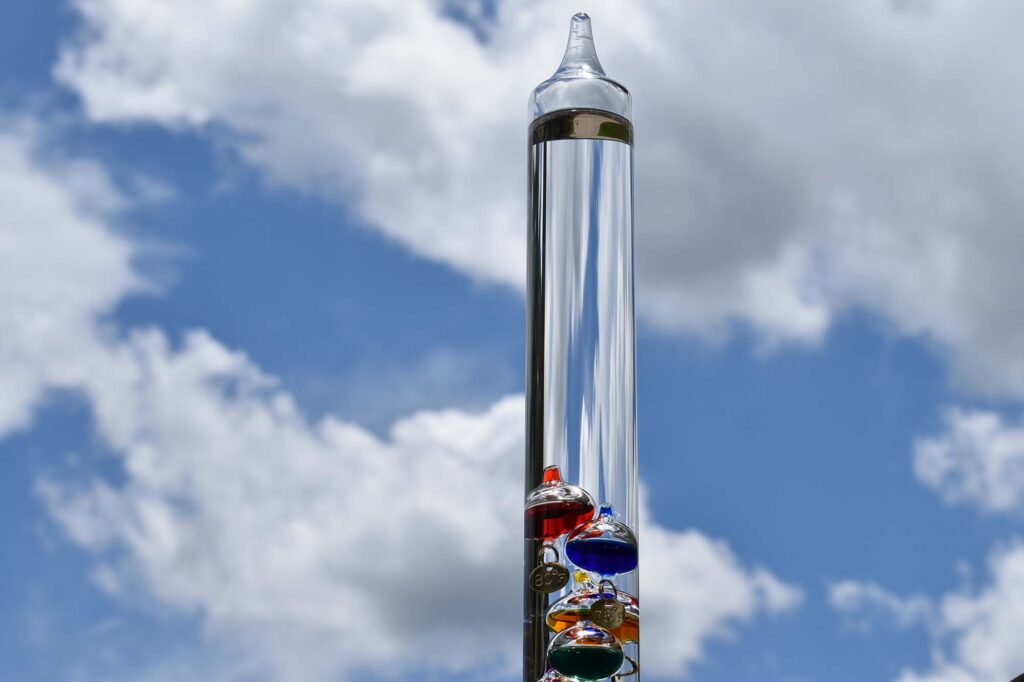
From Galileo to the Modern Thermometer
Over the years, the humble Galileo thermometer has paved the way for the development of modern thermometers that we rely on today. While Galileo thermometers were a breakthrough in their time, advancements in technology and scientific understanding have led to the creation of more accurate and efficient temperature-measuring devices.
One significant advancement in thermometer technology was the invention of the mercury-in-glass thermometer in the early 18th century. This innovation replaced the use of water and air in Galileo thermometers with mercury, which provided more precise temperature readings. The mercury thermometer quickly became the standard for measuring temperature and remained widely used for centuries.
However, concerns about the toxicity of mercury led to the development of alternative thermometer designs. In the late 20th century, digital thermometers emerged as a popular choice. These thermometers use electronic sensors to measure temperature and display the readings digitally. They offer quick and accurate results, making them convenient for both personal and professional use.
Another significant development in modern thermometers is the infrared thermometer. Instead of direct contact with the object being measured, these thermometers use infrared radiation to determine temperature. They are commonly used in medical settings, allowing for non-invasive temperature measurements.
In recent years, smart thermometers have also gained popularity. These thermometers can connect to smartphones or other devices via Bluetooth or Wi-Fi, allowing users to track and monitor temperature readings over time. They often come with additional features such as fever alerts and data analysis, making them valuable tools for healthcare professionals and individuals alike.
From the thermoscope to the thermometer
In conclusion, the history of thermometers is a fascinating journey that spans centuries and involves the contributions of numerous scientific pioneers. From the ancient thermoscope to Galileo’s groundbreaking discoveries, and from the invention of the mercury-in-glass thermometer to the modern digital and infrared thermometers, temperature measurement has evolved significantly.
The use of materials like glass and liquids such as mercury or alcohol in early thermometers laid the foundation for our understanding of temperature variations. However, concerns about toxicity and environmental impact have led to the development of safer alternatives, such as alcohol-based thermometers and digital sensors.
The Celsius and Fahrenheit scales are the most commonly used scales for measuring temperature, with the Kelvin scale being used in scientific and engineering applications. These scales provide standardized systems for temperature measurement, allowing for accurate and consistent readings.
The invention of electronic thermometers revolutionized temperature measurement, offering greater accuracy, convenience, and versatility. From thermistors to digital thermometers and infrared thermometers, electronic devices have become essential tools in various fields.
The Galileo thermometer, with its elegant design and use of buoyancy principles, serves as a reminder of the harmonious marriage between science and art. It represents the rich history and evolution of temperature measurement, capturing the imagination of both weather enthusiasts and the average reader.
As we look to the future, advancements in technology continue to shape the world of thermometers. Smart thermometers with connectivity features and advanced data analysis capabilities are becoming increasingly popular, providing valuable insights and convenience.
Whether it’s the iconic Galileo thermometer or the latest digital or infrared thermometer, these devices play a crucial role in our daily lives, from monitoring our health to understanding the weather. The history of thermometers is a testament to human curiosity, innovation, and the constant pursuit of knowledge.


